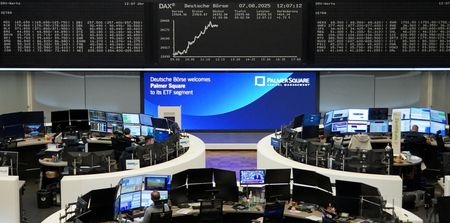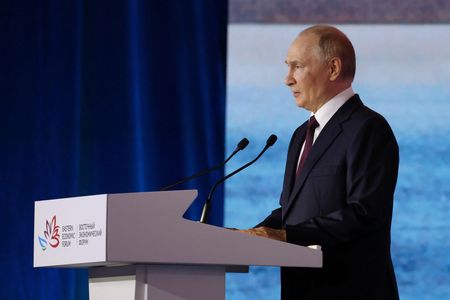(Reuters) – A look at the day ahead in European and global markets from Stella Qiu
Investors handled the shock surge in U.S. inflation extremely well given already limited scope for interest rate cuts. Benchmark Treasury yields shot up 10 basis points overnight but stock futures are actually firmer. Even the U.S. dollar is struggling to sustain the upward momentum that usually accompanies higher yields.
That is likely thanks to hope of a peace deal between Ukraine and Russia after President Donald Trump held phone calls with both countries’ leaders to discuss the end of their years-long war. China is also pushing for peacekeeping efforts to end the war, the Wall Street Journal reported.
The prospect of an end to sanctions on Russian oil increasing supply pushed oil prices down more than 3% since Wednesday. [O/R]
Nasdaq futures rose 0.4% while S&P 500 futures gained 0.2%. EUROSTOXX 50 futures climbed 1%, leaving them up almost 11% this year.
Shares are already at record highs in Europe, which is not yet in the firing line of Trump’s global trade war.
Meanwhile the euro has risen 0.5% to $1.0431, having bounced from a low of $1.0317 overnight even as Treasury yields jumped. It still faces heavy resistance at the January top of $1.0535.
The European Central Bank has more room to cut interest rates given inflation has been better behaved than in the U.S. Markets are pricing in three quarter-point moves to a terminal rate of 2%, while expectations are for the Federal Reserve to move only once this year to a floor of 4%. Just a few months ago, investors were looking for a bottom near 3%.
Over in Asia, one point of note is the 10% rise this year in shares in Hong Kong, the region’s best-performing major stock market. Providing a boost is the AI-driven rally in global shares finally arriving in China, ignited by buzz around AI startup DeepSeek and benefiting mostly tech giants such as Alibaba.
Next up, investors will be keeping a close eye on Europe’s reaction to developments in the Ukraine war. Analysts reckon it won’t be an easy process, with countries including aid donors Britain, France and Germany saying they had to be part of any negotiations on the fate of Ukraine.
And then there’s Ukraine itself. Being told to give up territory to an invader before the talks even start is not a bright beginning.
Britain will have its fourth-quarter gross domestic product data later in the day, with consensus seeing a decline of 0.1% in the quarter. Investors see at least two BoE rate cuts for the year.
The U.S. will have weekly jobless data as well as its producer price index, which could get more attention given the surprise surge in consumer prices. Forecasts are centred on a rise of 0.3% in the month for PPI.
Both of them will feed into the Fed’s preferred gauge of inflation – the Personal Consumption Expenditures Price index – which could determine if Fed has room to cut at all this year.
Key developments that could influence markets on Thursday:
* U.K. fourth-quarter GDP figures * Euro zone industrial production data for December * U.S. weekly jobless claims * U.S. PPI for January
(By Stella Qiu; Editing by Christopher Cushing)










